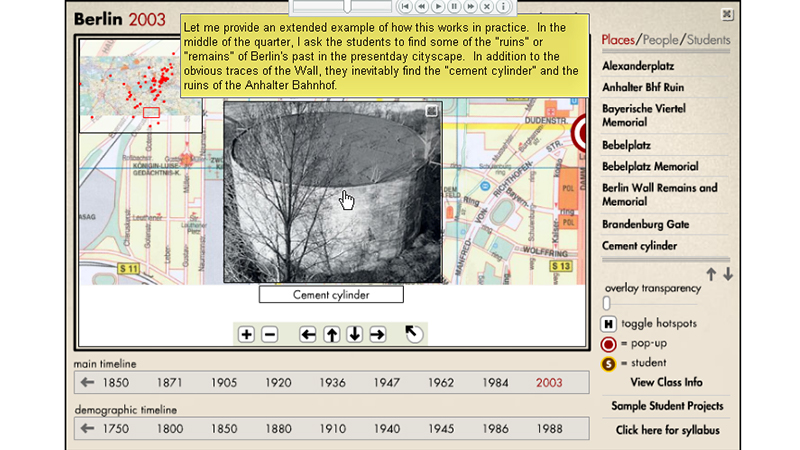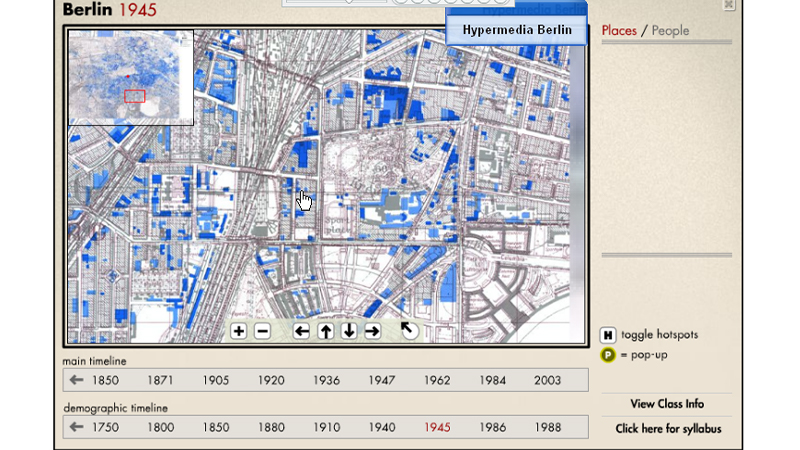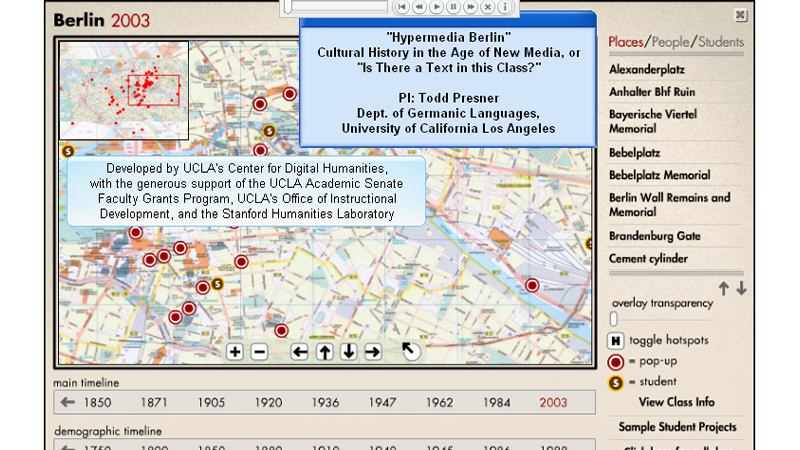Hypermedia Berlin draws up on "The Image of the City, [in which] urban planner Kevin Lynch showed that a city-dweller's sense of alienation correlated with the degree to which he or she could – or could not – mentally navigate surrounding streets and neighborhoods. Further, he found that a city's 'imageability,' which is linked to the presence of legible and identifiable kinds of markers, contributes to a sense of familiarity and the acceptance of the city as a recognizable place. [Hypermedia Berlin] extends Lynch's ideas through the creation of a series of layered maps of Berlin that not only chronicle the evolution and dissolution of the city's districts, architectural landmarks and boundaries through multiple chronologies, but that also reflect the city through diverging ideological lenses.
The project, designed to be shared with students and instructors internationally, offers a new form of scholarship in which 'visitors' discover the city's multifaceted history through its sedimented terrain. Rather than moving through the histories traditionally arrayed in linear text, Hypermedia Berlin invites users to begin in the streets, parks and landmarks that constitute the city and then to move either up or down on a temporal axis almost decade by decade, or outward, from one place to another. Further, Presner views the project as a foundation upon which others will build with the goal of crafting a rich and culturally dense collaborative 'hypertext encyclopedia.'
Hypermedia Berlin is the result of a collaboration between UCLA's Center for Digital Humanities and Stanford University's Humanities Laboratory. Based on a series of interdisciplinary courses taught in Palo Alto, Los Angeles and Berlin, Hypermedia Berlin is designed specifically for use in classrooms, where it offers a multidimensional platform for a variety of applications and may serve as a model for investigating other urban spaces." – Vectors Journal Editorial Staff
Author's Statement
"Hypermedia Berlin is a collaborative, multimedia, web-based research and curriculum development project, which investigates, analyzes, and maps the architectural, cultural, and historical layers of Berlin's city space. The project can be understood as a multimedia descendent of Walter Benjamin's famous attempt to map the Paris of the nineteenth century in the Arcades Project. Explicitly disavowing any kind of linear, chronological, or teleological model of historiography, Hypermedia Berlin, like the Arcades Project, is organized topographically in order to examine the complex relationship between cultural production, mobility, and space. While Benjamin attempted to create a 'montage' text to study Paris, I am proposing that the technologies of the Web and new media offer the possibility of conceptualizing a radically new approach to cultural history, something that Benjamin was not able to fully realize in the Arcades Project. I have to believe that Benjamin would have found the tools of new media, specifically the rhizomatic techniques of hypertext and the hypermedia possibilities of the World Wide Web, especially well suited to 'giving dates their physiognomy' and realizing what he once called 'the Copernican revolution in historical perception.'
Hypermedia Berlin is organized according to 'Zeitschichten,' or time-layers, in which the uneven spatial and temporal coordinates of Berlin's cultural and architectural histories can be apprehended. Unlike traditional models of history, which proceed chronologically and take the linearity of temporality as their structuring principle, Hypermedia Berlin attempts to articulate Berlin's time-layers through a multiplicity of maps connected together by interlinking 'hotspots' at key regions, structures, and streets. These maps function as historical palimpsests of the city, thereby spatializing historical practice and transforming cultural history into a kind of 'cultural geography.'
With the technical support of UCLA's Center for Digital Humanities as well as the financial support of UCLA's Academic Senate Faculty Grants Program, UCLA's Office of Instructional Development, and the Stanford Humanities Laboratory, the pilot version of Hypermedia Berlin was launched in the spring of 2004. I initially conceived of the project as a 'Hypermedia-Hypertextbook' of Berlin for use in the classroom. To this end, we began developing an extensive digital archive of interconnected maps and photographs of Berlin. As the project rapidly grew, it quickly became apparent that we would need to develop a content management system to edit, search, and present the vast amount of material. Moreover, we needed a way for students, researchers, and the general public to interact with and contribute to the site. We are currently developing the first content management system for Hypermedia Berlin. In addition to about fifty interconnected and fully annotated maps of Berlin over its nearly 800-year history, the site will include a digital library interface with a searchable database of photographs, an e-scholarship interface with peer-reviewed essays in hypertext format, an extensive blogger function for general authorship, and a customizable 'My-Hypermedia Berlin' that will allow teachers and students interested in any aspect of Berlin to excerpt and create their own course or research material. We hope to launch the content management system within a year, something that will distinguish Hypermedia Berlin as a unique research and curriculum development portal on the city.
For my Vectors' contribution, I created a Flash film of the first phase of the project in which I discuss both the pedagogical and research challenges that this media presents for historical methodology, disciplinary practice, and classroom pedagogy. The film runs about 15 minutes and can be paused, fast-forwarded, or rewound. To view the film, just launch the project. . . ." -- Todd Presner, -- from Vectors, Volume 1, Issue 2, Spring 2006
Designer's Statement
"UCLA's
Center for Digital Humanities consults with faculty in the Humanities
division who are working on projects that go beyond the capabilities of
our course-management system. In addition to technical expertise, CDH
provides the technical infrastructure that supports not just the faculty
member, but the graduate students who participate in the project as
well as the students who take the course.
CDH's technical team, led
by Eugene Horikawa, decided that Flash would be the most suitable venue
for developing the concept of interlinking time and space layers for Hypermedia Berlin. Because the time-map applications that we first
examined did not convey a sense of actually moving in time and space, we
looked to other programs to convey mobility. We discovered a product
called 'Zoomifier' for Flash, which gives users both a global and local
view of large-scale, highly detailed images by allowing them to zoom in
and out. The program allowed us to modify the core functionality (via
source code), giving us the ability to precisely control the
interactivity of the navigation.
We are sometimes asked whether users could gain the same experience from Powerpoint presentations. We believe that the freedom to navigate in a non-linear fashion creates a uniquely 'immersive experience' for the viewer moving through a new geographic space — similar to the way tourists 'learn' or become acquainted with a new city. Rather than learning the material as linear 'snapshots,' Hypermedia Berlin foregrounds the 'big picture' or the contextual relationships between the cultural artifacts that make up the site. By providing the context for each piece of content, we believe that users are more apt to engage in the interactive construction of a shared cognitive space.
Hypermedia Berlin is part of the 'incubating' process at CDH. The next steps will be to scale up the project and connect the interface with a more robust and persistent digital repository, one that is maintained by UCLA's Digital Library Program. This will include developing ways for peer-reviewed scholarly contributions to be incorporated into the site, making it an arena for scholarly collaboration and contribution. Other projects at CDH have taken inspiration from the time-map interface, and we are confident that the technology we have developed for mapping Berlin will be put to good use in other upcoming projects examining the relationship between space, mobility, and culture." -- Design Team, from Vectors, Volume 1, Issue 2, Spring 2006
Project Credits
"Hypermedia Berlin has been generously supported by UCLA's Center for Digital Humanities, UCLA's Academic Senate Faculty Grants Program, UCLA's Office of Instructional Development, and the Stanford Humanities Laboratory.
In addition to the project designers, I would also like to thank Rae Agahari, Ulli Bach, Annelie Chapman, Amir Eshel, Barbara Hui, John Maciuika, Jeffrey Schnapp, Joseph Vaughan, Claire Whitner, and Mika Yoshitake. — Todd Presner, May 19th, 2008
Todd Presner
Author
Todd Presner is Assistant Professor of Germanic Languages and Jewish Studies at the University of California Los Angeles. He is finishing two book projects: Dialectics at a Standstill: A Cultural Geography of German/Jewish Modernity and Muscle Jews and the Politics of Regeneration, 1890-1930." -- from Vectors, Volume 1, Issue 2, Spring 2006
1 COPY IN THE NEXT
Published in 2006 by Vectors in Volume 1, Issue 2.
This copy was given to the Electronic Literature Lab by Erik Loyer in November of 2021.
PUBLICATION TYPE
Online Journal
COPY MEDIA FORMAT
Web


